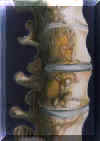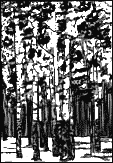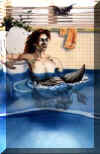Visual Analogy
The story through image
Bone Builders

The aging of the population diverts our sometimes-relutant attention toward those disorders of age that may not be lethal but
that diminish the quality of remaining life. Osteoporosis qualifies as
one of those disorders.
In recent years the ability to treat
osteoporosis underwent a major advance with discovery of bisphosphonates,
a class of drug that interferes with the bone-remodeling process,
a process that may become unbalanced in certain bone disorders
and with the decline of steroid hormones that occurs with age.
The adult skeleton is not a static entity. Bone is
constructed by osteoblasts and broken down by osteoclasts in
a constant process of remodeling. When breakdown
of bone exceeds production, the skeleton becomes fragile and
prone to fracture.
The class of drug known as bisphosphonates helps to restore
the remodeling balance by inhibiting the breakdown of bone.

Imagination is the one weapon in the war against reality.
Jules de Gaultier

P-Glycoprotein
Pump
(or how cancer cells adapt to chemotherapy)

Researchers were confounded by the fact that
initial success in chemotherapy was often followed by failure,
despite use of chemically dissimilar chemotherapeutic agents. Somehow,
cancer cells exposed to chemotherapeutic drugs "learned"
to recognize and extrude the drugs before they did their damage. It
turned out that the explanation for this ability lay in an early
mammalian adaptation.
One of the reasons mammals survived as a species was the p-glycoprotein
pump, a membrane-bound molecule that developed early in the
evolutionary process. When toxins entered the cell
on which this pump was located, it ejected them before they
damaged the cell. As mammals diversified and developed,
the pump diversified along with them. In time it branched
into a family of genes capable of protecting against various
toxins, even those containing different chemical substrates.
Contained in the genes of many cells, the pump can be expressed
upon exposure to toxic agents to commence its protective traits. When
cancer cells are exposed to but not killed by chemotherapeutic
agents, many of which are derived from such natural toxins as
snake and spider venom, the stage is set for expression of the
p-glycoprotein pump. Thus, the value of the pump and its
purpose hinges on one's perspective.
Pictured is the hydrophobic-and-hydrophilic pump, which disparate
(water-loving, water-avoiding) nature I felt was contained in
the form of the mermaid. She is associated with a
channel or pore through which toxins are extruded from the cell's
interior. Entering the cell behind her left shoulder
and not yet detected by her is the unlovely visage of an agent
toxic to the cell.

The
pIXY 321 Molecule
(or healing survivors of chemotherapy)

Chemotherapy works by killing rapidly dividing
cells. In adults, whose growth has stopped, rapidly dividing cells can be caused
by cancer.
But stem cells split quickly as well,
and are thus inadvertent victims of chemotherapy. Stem
cells reside in bone marrow, where they produce eventual blood cells and
assist the immune system. In this illustration stem cells
are shown as spheres.
Bacterial invasion of the body stimulates its inflammatory defense
in this way: When challenged by foreign invaders, macrophages
and other protective blood cells in the host exude growth factors
called cytokines. These cytokines affect stem cells,
causing them to divide and produce other types of blood cells
in a defensive inflammatory response. The new blood
cells diminish the adverse effects of chemotherapy, as well
as fight infection, in the host.
Cytokines are not created equal, and come in a variety of forms;
the two types shown here are synthetic. Cytokines
of any stripe attach by way of "keys" to receptors,
shown as "locks," on stem cells. Each unique
cytokine key fits its unique cytokine receptor on the stem cell. Sometimes
the different receptors to which different cytokines attach
happen to be adjacent on the stem cells. When they
are adjacent, and are simultaneously stimulated by their respective
cytokines, the stem cell proliferates, producing a much greater
quantity of protective blood cells. Thus, it would
be beneficial for defending stem cells to have adjacent receptors
for the cytokines IL-3 and GM-CSF simultaneously engaged.
Because chemotherapy kills stem cells, we assist those remaining
with synthetic IL-3 and GM-CSF growth factors. The
two depicted here are IL-3 (green seahorses) and GM-CSF (blue-gray
dragon). Although these synthetic drugs have keys
that fit the proper stem-cell receptor, they also have unwanted
side effects, designated by the fantastic shapes attached
to the synthetic keys.
A recombinant process has produced yet another synthetic growth
factor (with yet another unlikely name). pIXY 321,
as it is called, incorporates the useful parts of synthetic
IL-3 and GM-CSF while avoiding most side effects. Also,
because it is a single molecule, it increases the chance of
simultaneous binding to stem-cell receptors. It is depicted
as the key chain incorporating both dissimilar types of growth-factor
keys.
More production from the stem cells remaining after chemotherapy
assists the immune system of the host in fighting infection;
other lymphocytes made by stem cells produce their own natural-killer
cells that directly fight cancer. Soon, of course,
barring calamity, we will be able directly to attack cancer
cells, bypassing the damage we now inflict on cancer's host.
